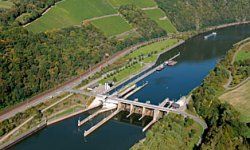Alternative energy isn't so "alternative" anymore. It's in the news, on political platforms, atop roofs and filling gas tanks, and the options have grown enough to change the conversation: It's not whether we want it, but which kind we want.
Most of our current energy consumption draws on fossil fuels. These fuels aren't renewable, and experts predict could they start running out as soon as 50 years from now. Plus, the combustion necessary to draw energy from fossil fuels releases vast amounts of pollution that lead to illness, ecological destruction and what's turning out to be a nasty case of global climate change.
Advertisement
Ideally, alternative energy sources are low-polluters, are they're renewable to varying degrees. The thing is, it's not cheap to develop any energy system from the ground up on a large scale, so we need to focus: Which are the most promising options out there? Where should we put our money and our innovation muscle?
Here are five of the most promising sources of energy that could take us, eventually, away from our dependence on fossil fuels. No single source is perfect, but each is potentially a path toward clean, renewable power.
First up, from deep in the Earth …
